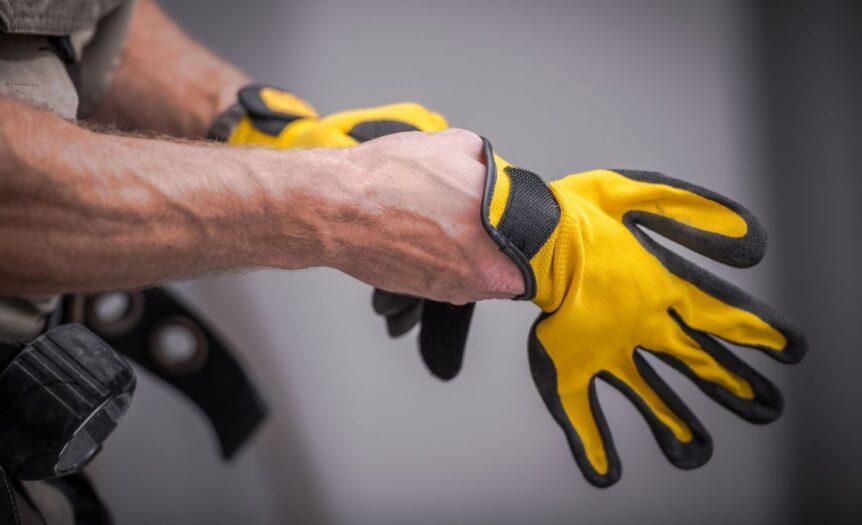Work gloves are essential for many industries. They protect from dirt, debris, chemicals, and more. But not all work gloves are equal; there are several types available, each with its unique set of benefits.
Let’s take a closer look at the different types of work gloves and the situations in which you should use them.
Leather Gloves
Leather is one of the most common materials used to make work gloves. Leather is naturally durable and long-lasting, making it an ideal choice for workers who need protection against abrasive surfaces or sharp objects. It’s also quite flexible, which makes it comfortable to wear over long periods. Leather is also resistant to heat and cold, making it a great choice for outdoor jobs requiring thermal protection.
Synthetic Gloves
Synthetic materials, such as nylon and polyester, are often in work gloves because they’re lightweight and breathable. These materials make gloves perfect for jobs that require precision or dexterity, such as electronics assembly or automotive repair. Synthetic materials are also generally less expensive than leather. As a result, they’re perfect for those on a budget. However, synthetic materials don’t offer as much protection against extreme temperatures or sharp objects as leather does.
Rubber Gloves
Rubber is another popular material for work gloves because it offers superior grip in wet environments like kitchens and factories where liquids might be present. It’s also highly resistant to punctures and chemicals, making it ideal for hazardous industrial settings or laboratories. However, rubber can be uncomfortable for long periods due to its poor breathability.
Cut-Resistant Gloves
Cut-resistant gloves protect workers from sharp tools or machinery parts. They use special fabrics that manufacturers design to withstand cuts from blades. Still, they remain flexible enough for hand movement while wearing them. They can have various materials, including Kevlar, Spectra, Dyneema, stainless steel mesh, etc. The composition a worker chooses depends on the level of cut resistance they require for their particular application.
Work gloves come in all shapes and sizes, so you should always consider your specific needs before purchasing any pair. This way, you can ensure maximum safety while working with hazardous materials or equipment. Finding well-fitting work gloves can make all the difference in your comfort and safety while on the job.
Knowing what the different types of work gloves are will help you make an informed decision when choosing the right pair for your job! From leather to synthetic materials to rubber and cut-resistant fabrications, glove features exist that will meet your needs!










 Deering Estate
Deering Estate
 Massage Envy South Miami
Massage Envy South Miami
 Calla Blow Dry
Calla Blow Dry
 My Derma Clinic
My Derma Clinic
 Sushi Maki
Sushi Maki
 Sports Grill
Sports Grill
 The Healthy Kitchen
The Healthy Kitchen
 Golden Rule Seafood
Golden Rule Seafood
 Malanga Cuban Café
Malanga Cuban Café

 Kathleen Ballard
Kathleen Ballard
 Panter, Panter & Sampedro
Panter, Panter & Sampedro
 Vintage Liquors
Vintage Liquors
 The Dog from Ipanema
The Dog from Ipanema
 Rubinstein Family Chiropractic
Rubinstein Family Chiropractic
 Your Pet’s Best
Your Pet’s Best
 Indigo Republic
Indigo Republic




 ATR Luxury Homes
ATR Luxury Homes


 2112 Design Studio
2112 Design Studio
 Hamilton Fox & Company
Hamilton Fox & Company
 Creative Design Services
Creative Design Services
 Best Pest Professionals
Best Pest Professionals
 HD Tree Services
HD Tree Services
 Trinity Air Conditioning Company
Trinity Air Conditioning Company
 Cisca Construction & Development
Cisca Construction & Development
 Mosquito Joe
Mosquito Joe
 Cutler Bay Solar Solutions
Cutler Bay Solar Solutions


 Miami Royal Ballet & Dance
Miami Royal Ballet & Dance
 Christopher Columbus
Christopher Columbus
 Pineview Preschools
Pineview Preschools
 Westminster
Westminster
 Carrollton
Carrollton
 Lil’ Jungle
Lil’ Jungle
 Frost Science Museum
Frost Science Museum
 Palmer Trinity School
Palmer Trinity School
 South Florida Music
South Florida Music
 Pinecrest Orthodontics
Pinecrest Orthodontics
 Dr. Bob Pediatric Dentist
Dr. Bob Pediatric Dentist
 d.pediatrics
d.pediatrics
 South Miami Women’s Health
South Miami Women’s Health

 The Spot Barbershop
The Spot Barbershop
 My Derma Clinic
My Derma Clinic




 Miami Dance Project
Miami Dance Project

 Rubinstein Family Chiropractic
Rubinstein Family Chiropractic
 Indigo Republic
Indigo Republic

 Safes Universe
Safes Universe
 Vintage Liquors
Vintage Liquors
 Evenings Delight
Evenings Delight





 Atchana’s Homegrown Thai
Atchana’s Homegrown Thai
 Baptist Health South Florida
Baptist Health South Florida

 Laser Eye Center of Miami
Laser Eye Center of Miami
 Visiting Angels
Visiting Angels
 OpusCare of South Florida
OpusCare of South Florida

 Your Pet’s Best
Your Pet’s Best





 HD Tree Services
HD Tree Services
 Hamilton Fox & Company
Hamilton Fox & Company


 Creative Design Services
Creative Design Services